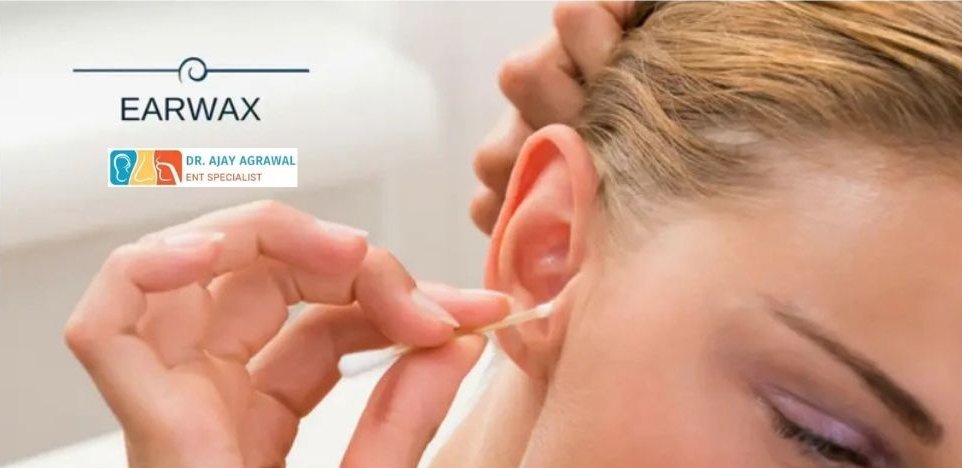Ear Wax
Dr. Ajay Agrawal: Expert in Ear Wax Treatment and Management in Indore

Understanding Earwax and How It Forms
Earwax is a natural substance produced by glands in the ear canal. Its primary function is to protect the ear by trapping dust, dirt, and other foreign particles, thus preventing them from reaching the eardrum. Additionally, earwax acts as a lubricant, keeping the ear canal moist and preventing dryness and itchiness. However, when this earwax accumulates, it creates a blockage in the ear canal, which results in ear pain, vertigo (dizziness), hearing loss , and other issues. Dr. Ajay Agrawal is a renowned ENT doctor in Indore, who, with his expertise and experience, provides proper ear wax treatment in Indore, ensuring effective procedures for treating and managing earwax buildup.
Causes of Earwax Buildup
While earwax is essential for ear health, it can sometimes accumulate and cause blockages. One common cause of earwax buildup is improper cleaning practices. Many people attempt to remove earwax using Q-tips, bobby pins, or other objects. However, these methods can push the earwax deeper into the ear canal, leading to impaction. Furthermore, individuals who regularly use hearing aids or earplugs are more prone to earwax buildup. These devices can interfere with the natural migration of earwax out of the ear canal, allowing it to accumulate over time. This causes major earwax buildup in the ear canal. To know more about proper ear wax treatment in Indore and to avoid these common pitfalls, consult Dr. Ajay Agrawal. He provides expert ear wax treatment in Indore, ensuring your ears stay healthy and free from blockage.
Symptoms of Earwax Buildup
Hearing Impairment
Excessive earwax can obstruct the ear canal, leading to reduced hearing or a sensation of plugged ears.
Ear Pain
Mild ear pain or discomfort may occur, especially if the wax buildup causes pressure against the ear canal walls. This major accumulation of earwax causes ear pain.
Vertigo
In some cases, earwax impaction can affect the balance organs in the inner ear, causing dizziness or vertigo.
Reflex Cough
Irritation of the auricular branch of the Vagus nerve, which runs near the ear canal, can trigger a reflex cough in some individuals.
Complications
Long-standing earwax impaction can lead to complications such as ulceration of the skin lining the ear canal or the formation of a wax granuloma (a type of skin growth). If you have any such complications, consult Dr. Ajay Agrawal, an ENT doctor in Indore, to address the issue.
Treatment of Earwax Buildup at Home
Fortunately, mild cases of earwax buildup can often be managed at home with simple interventions. Here are some tips from Dr. Ajay Agrawal, an ENT Doctor in Indore for addressing earwax buildup:
Wax Softening Drops
Over-the-counter wax softening drops, such as Debrox or Murine, can help loosen and break down earwax. Follow the instructions on the product label, and allow the drops to remain in the ear for several minutes before draining them out.
Warm water irrigation
Using a bulb-type syringe, gently flush the ear with warm water to help remove softened earwax. Ensure that the water is at body temperature to avoid causing dizziness or discomfort.
Avoid Ear candling
Ear candling, a popular alternative remedy, involves inserting a hollow candle into the ear and lighting it to purportedly draw out earwax. However, this practice is not recommended by healthcare professionals and can potentially cause injury or worsen earwax buildup.
When to consult an ENT doctor in Indore
The excessive earwax buildup causes ear pain and leads to hearing impairment. If home remedies do not provide relief or if you experience severe symptoms, it's essential to consult an ENT specialist. Dr. Ajay Agrawal, an ENT doctor in Indore, can safely remove impacted earwax using specialized tools and techniques, thus providing the best and most proper treatment for your earwax buildup.
Preventing earwax buildup
To minimize the risk of earwax accumulation, it's important to adopt proper ear care practices. Avoid inserting objects into the ear canal, as this can push wax deeper and increase the likelihood of blockages which causes ear pain. Instead, gently clean the outer ear with a soft cloth or tissue. If you use hearing aids or earplugs, follow the manufacturer's instructions for cleaning and maintenance. Regularly inspect your devices for wax buildup and clean them as recommended. By maintaining good ear hygiene and seeking prompt treatment for any symptoms of earwax buildup, you can help preserve your hearing health and prevent complications associated with excessive earwax.






